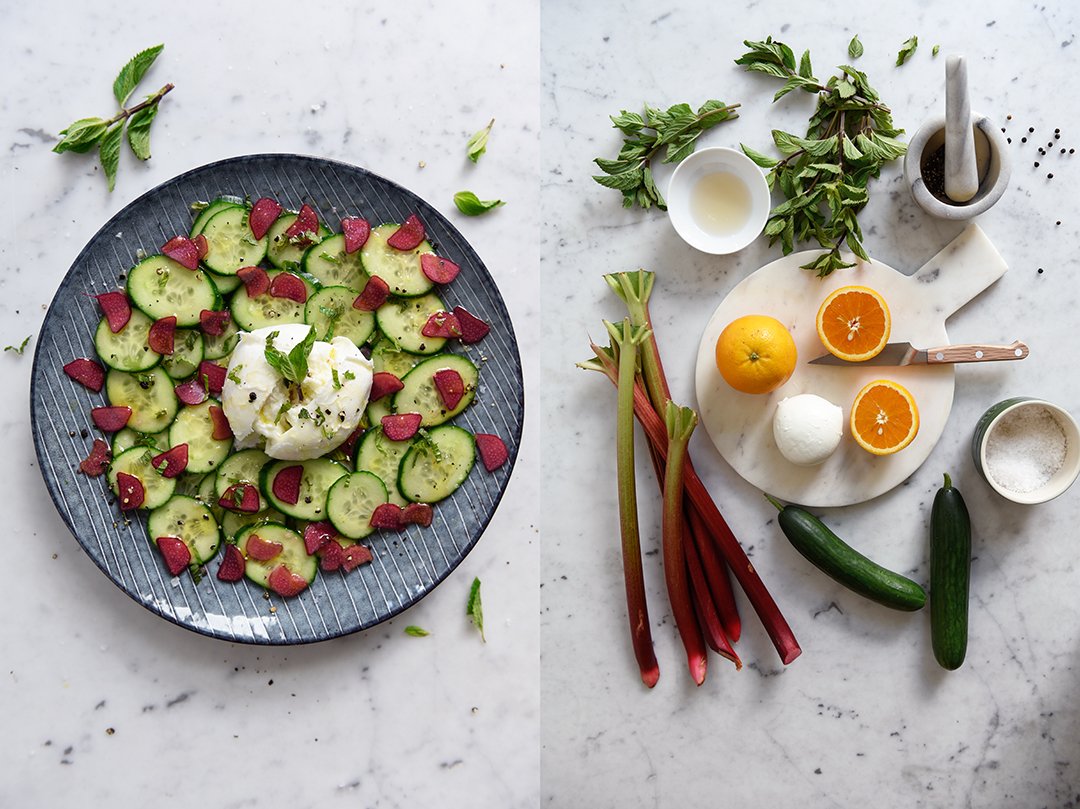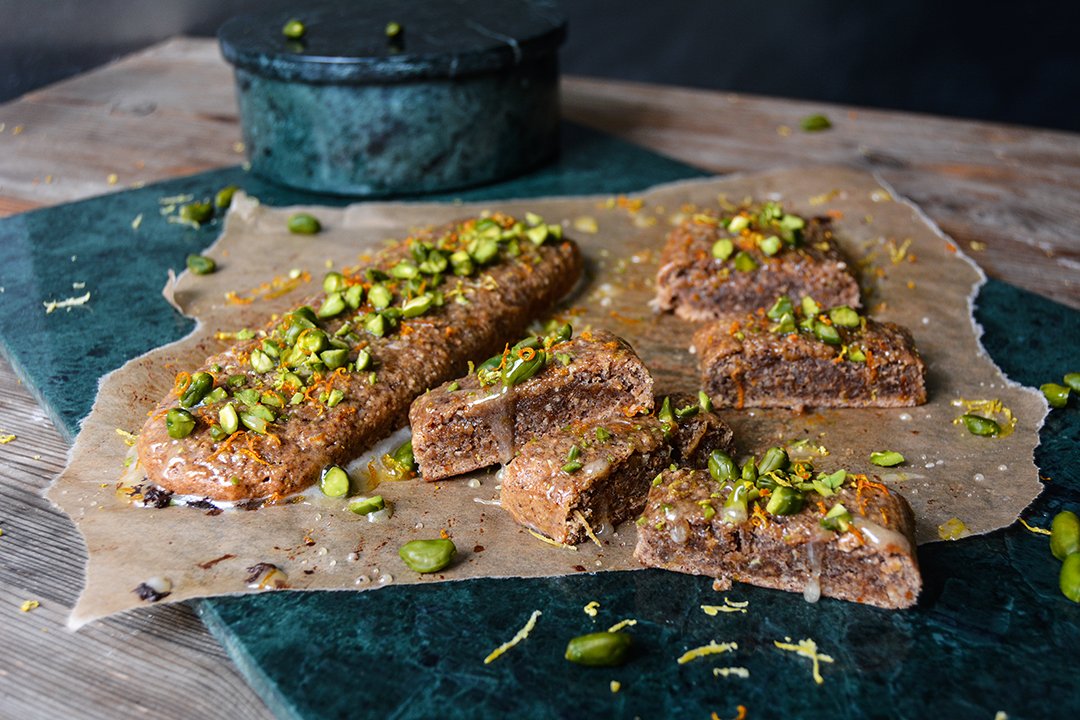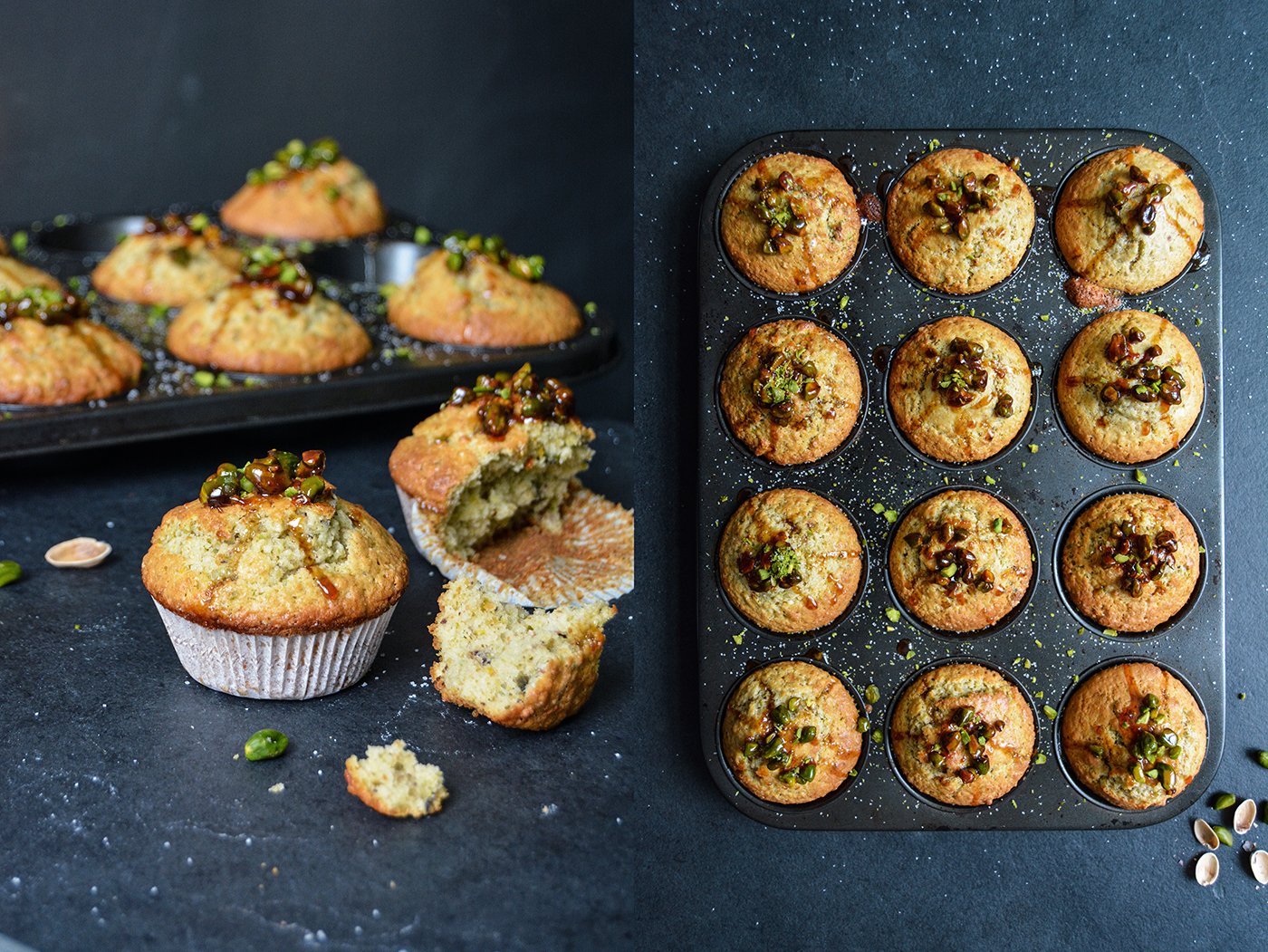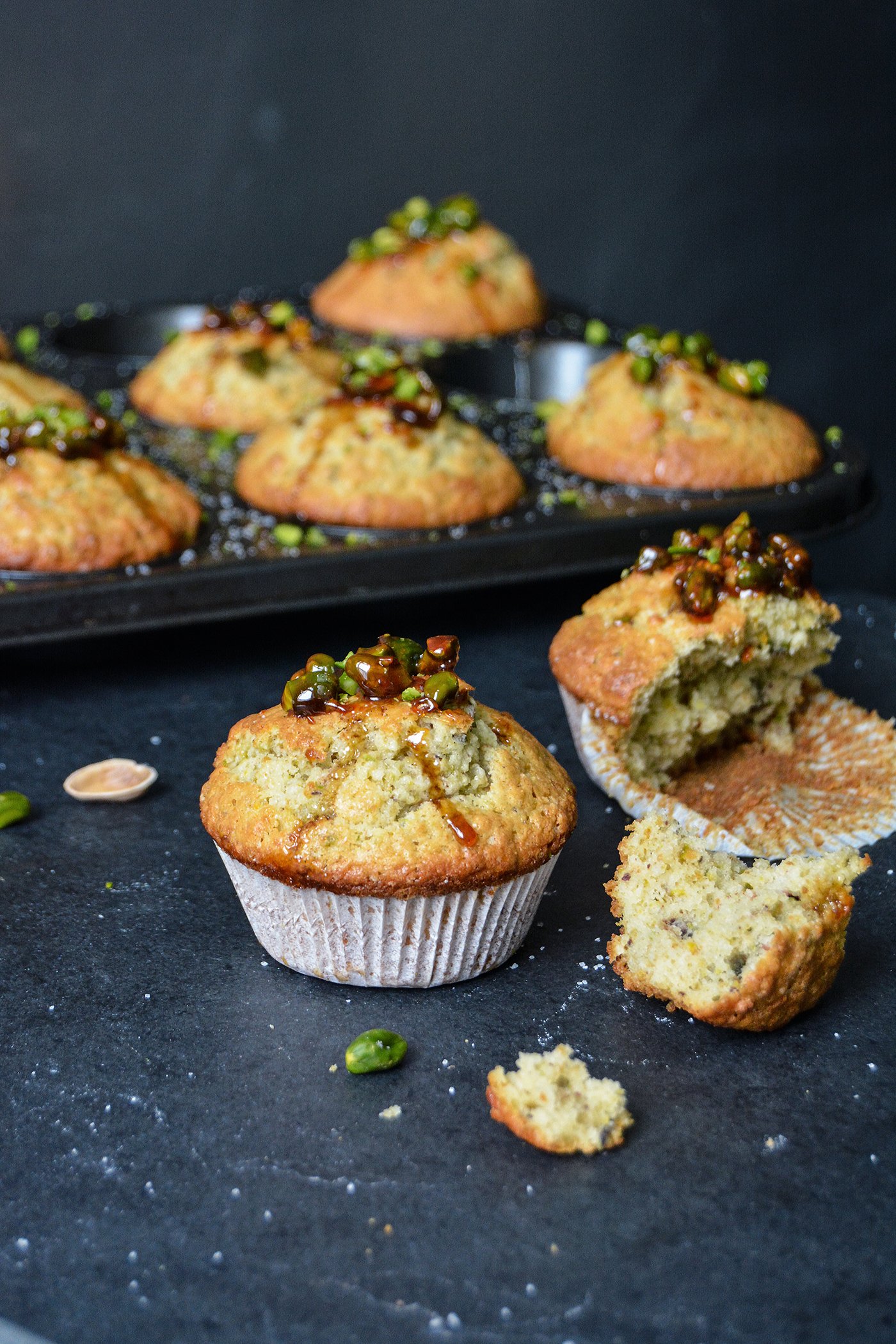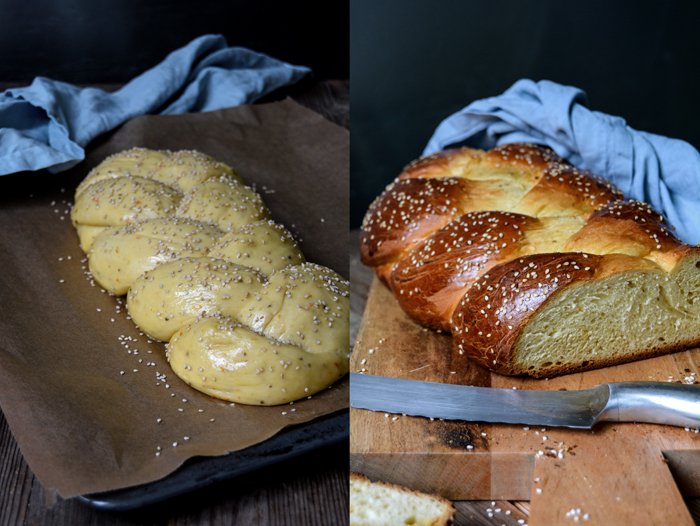Rhubarb and Cucumber Caprese
After months of calming my mind and palate with familiar comfort dishes - creating a soothing counterpart to the uncertainties in the world - I suddenly feel a growing appetite for kitchen experiments again. Pizza, spaghetti Bolognese, German stews and roasts, and yes, baking sourdough bread, gave me comfort and safety while the world turned upside down and pulled me off my feet. But I recently started to feel curious and hungry again, searching and finding a refreshing caprese salad with pickled rhubarb, orange blossom water, cucumber, mozzarella di bufala and mint.
As I leaved through Marc Diacono's fabulous new book, Sour, which was nominated for a James Beard Award this year, I immediately stopped on page 147 as I spotted a vibrant pink Rhubarb and Radish Salad. Marc uses raw rhubarb that he cuts very thinly and marinates in rose water. That made me think. I always cook, bake or roast rhubarb and wasn't quite sure if I'd fall in love with its distinct taste and texture when raw. The British cookbook author adds blue cheese and dill and this, in combination with the rose water, wraps it up snugly. It's sour, it's bold and somehow harmonic, or in Marc's words: "The rose water sets everything off and encourages the radish and rhubarb to sit a little closer together while retaining their independence."
So I asked myself, would that also work with orange blossom water? And what about quickly pickling the rhubarb first and adding crisp cucumber and a hint of fresh mint? I find blue cheese too strong for cucumber but a creamy mozzarella di bufala or Burrata would work. All of a sudden I had a very unusual caprese salad in front of me that had all the crispness, sourness and excitement that I was hoping for. To be fair, one can only truly appreciate this unorthodox caprese variation if one loves sour and is up for having some fun with an Italian classic. I have a Winter Caprese with Blood Orange, Beet and Mozzarella di Bufala in my 365 book and when I came up with that recipe I understood that a) a good mozzarella di bufala and especially Burrata can deal with strong flavors and b) playing with a traditional recipe is a good way to keep tradition alive.
Rhubarb and Cucumber Caprese
Serves 2
1 slim rhubarb stalk (around 60g / 2 ounces), trimmed and thinly sliced with a mandoline slicer or sharp knife
60ml / 1/4 cup white balsamic vinegar
2 teaspoons granulated sugar
60ml / 1/4 cup orange blossom water (or freshly squeezed orange juice)
flaky sea salt
1 small / Persian cucumber (with skin, rinsed), thinly sliced with a mandoline slicer or sharp knife
125g / 4.5 ounces mozzarella di bufala or Burrata
2 tablespoons freshly squeezed orange juice
2-3 tablespoons olive oil
crushed or coarsely ground black peppercorns
4-6 fresh (young) mint leaves, very finely sliced
Transfer the rhubarb to a medium, heat-resistant bowl. In a small saucepan, bring the vinegar, sugar and a pinch of salt to a boil. Stir in the orange blossom water, keep it on the heat just until it starts boiling then pour over the rhubarb and let sit for about 1 hour. You will use the rhubarb and the pickling liquid for the caprese salad.
Quicker but less satisfying: In a small bowl, mix the rhubarb with 2 tablespoons of vinegar, 2 tablespoons of orange blossom water, 1 teaspoon of sugar and a pinch of salt and let sit for 10 minutes. The texture will be tougher and not as crisp compared to the properly pickled rhubarb described above.
Spread the cucumber and 1/3 of the pickled rhubarb on a large plate, adding more rhubarb once you tasted it, and arrange the mozzarella in the middle. In a small bowl, whisk together 2 tablespoons of the pickling liquid and 2 tablespoons of orange juice then drizzle over the salad. Drizzle with the olive oil, sprinkle with a little salt, pepper and mint (mind that the mint is very powerful!). Taste and add more of the pickling liquid if you prefer more of a sour note. Enjoy the salad immediately.
Kwareżimal - Maltese Easter Sweets without Eggs and Butter
No eggs and no butter, but lots of spice and flavour and a soft and chewy texture. Maltese Kwareżimal are an almost guilt-free pleasure that tastes so good, that I ask myself why I didn't bake them earlier.
This ancient treat dates back to the medieval times, when the Knights in the Mediterranean traditionally baked Kwareżimal during Lent. The little dark brown loaves are made without dairy products, just ground almonds (or hazelnuts in my recipe), spices, and honey create a beautifully fragrant cakey sweet. Sugar was allowed, as it was seen as a spice in those days. It's not a healthy bar after all.
The name derives from the Latin word quaresima, the 40 days of the Lenten season. Although you can find Kwareżimal in some confectionaries on the Maltese islands throughout the whole year, my favourite bakery for sweet treats, Busy Bee, only pulls them out of the oven as Easter is nearing. The problem was that I have never been to Malta around this time, so I had no idea how good Kwareżimal tastes. I knew that I wanted to try them at Busy Bee first and thanks to Jessica and Luke this day has finally come. Our friends visited us a couple weeks ago and gave me - besides many other goods - this plain looking miniature cake as a present. It only took me 12 years to have my first bite of Kwareżimal and it was pure enjoyment. I didn't share a piece with anyone.
So I finally knew what I was aiming for, I felt ready to give it a go. My Kwareżimal are made with ground hazelnuts, as my Maltese man doesn't like almonds, but feel free to use whatever nut you prefer. I mixed in some white spelt flour (plain flour woks just as well) to lighten up the texture. But don't worry, it's still as soft and chewy as it should be thanks to the juice of half an orange.
The texture is divine, almost moist, it reminds a bit of rough marzipan. And it tastes so rich, nutty, and citrusy, with strong tones of rather Christmassy spices, such as cinnamon, cloves, citrus zest, and flowery orange blossom water. I went for a crunchy pistachio topping, bedded on sticky honey running down the sites of my little Kwareżimal. You can also chop almonds or hazelnuts. When you buy this sweet from a shop, you get a single bar, not more than 12cm / 5" long, that was my measure. To serve, I cut it in thick slices - it's a bit like a cookie with a chewy feel.
Kwareżimal
Makes 2 small bars (serves 2-4)
finely ground hazelnuts (or almonds) 120g / 1 cup plus 2 tablespoons
plain flour (I used white spelt flour / type 630) 100g / 3/4 cup
granulated sugar 100g / 1/2 cup
cocoa powder 1 teaspoon
baking powder 1/8 teaspoon
fine sea salt 1/8 teaspoon
ground cinnamon 1 teaspoon
freshly grated nutmeg 1/4 teaspoon
cloves, finely ground in a mortar, 1/2 teaspoon
vanilla bean, scraped, 1/4
freshly grated orange zest 2 generous teaspoons
freshly grated lemon zest 2 generous teaspoonsf
reshly squeezed orange juice 60ml / 1/4 cup
honey 1 tablespoon
high quality orange blossom water (preferably organic) 2 tablespoons
candied orange peel, finely chopped, 1 tablespoon
For the topping
honey 2 tablespoons
freshly squeezed orange juice 1 teaspoon
shelled unsalted pistachios, roughly chopped, a small handful
freshly grated orange zest 1/2 - 1 teaspoon
Preheat the oven to 180°C / 350°F (preferably convection setting) and line a baking sheet with parchment paper.
In a large bowl, whisk together the ground hazelnuts, flour, sugar, cocoa powder, baking powder, salt, cinnamon, nutmeg, cloves, vanilla seeds, orange zest, and lemon zest.
In a small saucepan, heat the orange juice and honey over low heat and whisk until the honey has melted. Take off the heat and whisk in the orange blossom water. Let it cool for a couple minutes, then stir into the dry mixture. Add the candied orange peel and stir until well combined. The dough will be soft, but you should be able to form a bar; if it's too soft, add a little more ground hazelnuts.
Wet your hands lightly, divide the dough in half, and form 2 bars, about 5cm / 2" wide and 2cm / 3/4" tall. Mind that they aren't too flat or they will dry out in the oven. Bake for about 15 minutes, the top of the loaves should still be soft and just slightly baked.
While the Kwareżimal are baking, prepare the topping: in a small saucepan, heat the honey and orange juice over medium heat and whisk until combined. Take the pan off the heat.
Brush the warm Kwareżimal with the warm honey and sprinkle with the pistachios and a little orange zest. To serve, cut into thick slices. Wrapped in cling film, it stays fresh for days.
Pistachio Orange Blossom Muffins with Caramelized Pistachios
Pistachios have been on my mind since I tried the most divine breakfast spread during my stay at the stunning Villa Athena in Agrigento in Sicily. Velvety smooth and creamy, slightly sweet and nutty, I'm not surprised that this traditional Sicilian Crema di Pistacchi is so popular in Italy. The texture is similar to the more common chocolate hazelnut spread, but it tastes a million times better, and it's bright green. I love it and I can't wait to start working on my own recipe.
However, there are much quicker ways to satisfy my current pistachio longings, for example, with fluffy pistachio orange blossom muffins topped with caramelized pistachios. I replaced a quarter of the flour with finely ground pistachios and stirred in a few roughly chopped nuts to add some crunch. Oranges team up very well with the green nuts, so I used a generous splash of orange blossom water and freshly grated zest to refine my little green muffins with a citrusy note. While you caramelize the nuts for the topping, you could also make a little more dark caramel to drizzle over the muffins' golden tops. Bittersweet and sticky, it fits really well, but that's up to you.
Yesterday was a great day, as we felt the united power of women. When I saw the pictures of the women's marches all over the world, hundred thousands of women raising their voice and showing their strength, I felt, all of a sudden, the cold fading that gathered in my heart in the past few months. #womensmarch
Pistachio Orange Blossom Muffins
Makes 12 muffins
shelled salted pistachios 120g / 1 cup
plain flour 320g / 2 1/2 cups
granulated sugar 150g / 3/4 cup
baking powder 3 teaspoons
baking soda 1/2 teaspoon
fine sea salt 1/8 teaspoon
butter, melted and cooled, 120g / 1/2 cup
freshly grated orange zest 1 teaspoon
vanilla pod, split and scraped, 1/4
whole milk 210ml / 3/4 cup plus 2 tablespoons
organic eggs 2
quality orange blossom water, preferably organic, 3 tablespoons
paper muffin pan liners 12
For the caramelized pistachios
shelled salted pistachios, a handful
granulated sugar 2 tablespoons
water 2 tablespoons
honey 1 teaspoon
Preheat the oven to 200°C / 400°F (preferably convection setting). Line a 12-cup muffin pan with paper liners.
In batches, rub the pistachios between your hands until most of the salt is scrubbed off. (Alternatively, use unsalted pistachios, in that case add 1/4 teaspoon of salt to the dough instead of 1/8 teaspoon.)
For the muffins, in a food processor or blender, grind 2/3 (80g / 3 ounces) of the pistachios until very fine. Chop the remaining pistachios roughly.
In a large bowl, whisk together the flour, ground pistachios, sugar, baking powder, baking soda, and salt.
Add the orange zest and vanilla seeds to the butter, whisk, and let it sit for a few minutes to infuse the butter.In a medium bowl, whisk together the butter, milk, eggs, and orange blossom water. Add to the flour-mixture and stir with a wooden spoon just until a lumpy batter forms. Gently fold in the remaining chopped pistachios. Mind that if you mix the batter too much, the muffins will lose their light texture.
Spoon the batter into the muffin cups and bake for about 14 minutes (slightly longer if using a conventional oven) or until golden.
For the caramelized pistachios, rub the pistachios as mentioned above to remove most of the salt and chop roughly. In a small, heavy saucepan, bring the sugar, water, and honey to the boil and, without stirring, let it cook until golden and caramelized. Add the pistachios, stir quickly and top each muffin with a teaspoon of the caramelized nuts. Work quickly, as the caramel becomes hard. If it's too sticky, transfer the pan back onto a low heat to melt the caramel.
Tsoureki - Greek Braided Easter Bread with Aniseed and Orange Blossom Water
Patience is a tricky thing, I feel it growing with every year I gain, but it still manages to drive me crazy at times. After about one year of working on my cookbook, eat in my kitchen, developing the recipes, cooking, baking and shooting them all by myself, then going through a long process of filling the pages with my little stories connected to each and every dish, I feel a rising impatience to bring this project to an end. Month after month of working closely with my fantastic team in New York, Munich, Berlin, and London, having a daily exchange and constant flow of ideas between me and my editors, photo retoucher, and book designer; all this leaves me hungry. I want to hold the fruit of our work in my hands so badly. My friends constantly make little jokes about me as they only see me with my laptop, glued to my chair at our long wooden dining table, which I turned into my office, or busy in the kitchen. To them, it seems like I, the chair, and the table have become one in the past year.
In German, there is a beautiful word called Vorfreude, which you could translate to the happy excitement you feel connected to a positive event lying in the future. This Vorfreude keeps me going. Sometimes I just feel my heart jump, when I think of the dedication I wrote on one of the first pages of my book for someone who means a lot to me, when I virtually thumb through the pages of my book which is still a file on my computer, or when I first saw the cover design, which I'll share with you soon! And I'm willing to wait for these moments, I'm willing to wait to make this book better and better with every correction, addition, and change we make, and then one day, it will be printed and I'll look at it and remember all the excitement, happiness, and frustration that's woven into every single page of it.
Baking can be a good teacher for life and a master when it comes to patience, especially baking with yeast. It will be Easter Sunday in a week and a sweet braided yeast bread is one of the most delicious and fragrant treats that one can have on the breakfast or coffee table on this special day. But this bread takes its time, you can't really rush - although I still try and succeed by letting the dough rise in the warm oven. It's a little quicker but you still have to be patient.
This year I go for a traditional Greek Easter bread called Tsoureki. It's soft and fluffy, enriched with butter and eggs, and flavoured, often refined with mahlep, a ground spice made of wild cherry seeds, and mastic, sun-dried resin. More modern variations feature vanilla and cardamom but I was after a different flavour combination: aniseed and orange blossom. Years ago, I spent a couple weeks on the Greek island of Naxos and I enjoyed one of the fluffiest yeast buns with aniseed and orange in the shade of an old chapel high up on a hill. This picture in mind, I knew what my Tsoureki would taste like. It smells so beautiful and aromatic like the air in the Mediterranean, anise and orange merged in a scrumptious breakfast bread sprinkled with nutty sesame. I only left it in the oven for a little too long, just a couple minutes, but I have an excuse. Two of my cousins stopped by for an unexpected quick visit, a family chat at the table and the bread was forgotten. At one point I thought "Wow, it smells so good!", so I ran to the oven and pulled out this nicely risen beauty (with a dark bottom).
Here's another sweet braided bread I made and shared 2 years ago.
Tsoureki - Greek Easter Bread with Aniseed and Orange Blossom Water
Makes 1 large loaf
plain flour 520g / 4 cups
granulated sugar 100g / 1/2 cup
fast-acting yeast 1 sachet (7g / 1/4 ounce)
fine sea salt 1/2 teaspoon
aniseed, lightly crushed in a mortar, 2 teaspoons
zest of 1 small orange
milk, lukewarm, 150ml / 2/3 cup
unsalted butter, melted, 100g / 1/3 cup plus 2 tablespoons
organic eggs 2
orange blossom water 2 tablespoons
sesame seeds, for the topping, 1-2 tablespoons
For the glaze
organic egg yolk 1
water 1 tablespoon
In a large bowl, combine the flour, sugar, yeast, salt, aniseed, and orange zest. Whisk together the milk, butter, eggs, and orange blossom water - the mixture should be lukewarm - and add to the flour mixture. Using the dough hooks of an electric mixer, knead for about 5 minutes until well combined and smooth. Continue kneading and punching with your hands for about 7 minutes until you have a soft and silky ball of dough. Place the dough back in the bowl, cover with a tea towel, and let rise in a warm place, or preferably in a 100°F (35°C) warm oven, for 100 minutes or until well risen (it won't double in size). Rising at room temperature prolongs the process.
Punch the dough down, take it out of the bowl, and knead for about 30 seconds, then divide into 3 parts and roll them into long sausage shapes. Lay the ends of the rolls on top and braid them tightly. Bend both ends of the bread under the loaf and transfer to a baking sheet lined with parchment paper. Cover with a tea towel and let it rise in a warm place for 50 minutes or until fluffy.
Preheat the oven to 180°C / 350°F (conventional setting).
Whisk the egg yolk and water for the glaze and brush the top of the loaf, sprinkle with sesame. Bake in the oven for 40-50 minutes, cover the loaf with aluminium foil after 15 minutes to prevent it from getting too dark. When the bread is done, it should be golden brown, knock on its bottom, it should sound hollow. Let it cool for a few minutes before cutting it into thick slices, and enjoy with butter.
Orange and Fennel Couscous with Orange Blossom Water and Mint
I decided to make couscous and cooked enough to feed a family of six - it shows that I don't work with this grain very often. The package looked tiny but the result was humongous! It didn't do the pleasure any harm though, the recipe was delish, we just had enough couscous for days.
Inspired by a phone call with my mother and our obligatory recipe exchanges, I mixed the earthy North African dish with crunchy fennel sliced like carpaccio and juicy orange fillets. To focus on the citrus a little more, I roasted orange peel in olive oil in the oven to create a fragrant oil and some crunchy citrus bites. An open bottle of orange blossom water in my fridge convinced me to go for an orange trilogy - a good choice. Each of them added their individual depth, texture and aroma: the juices of the fruit paired beautifully with the crisp peel and the flowery scented water. Fresh mint leaves on top to finish it off and three happy people at the table ate far more couscous than we ever have before.
Orange and Fennel Couscous with Orange Blossom Water and Mint
Serves 4
olive oil
long strips of orange peel 6
oranges, cut into fillets, 2
freshly squeezed orange juice 3 tablespoons (collected while cutting the fillets)
fennel bulb, very thinly sliced (like carpaccio), the green chopped, 1 (about 250g / 9 ounces)
couscous 300g / 10 1/2 ounces
quality orange blossom water (preferably organic), to taste
salt and pepper
fresh mint leaves, a small handful
Set the oven to 220°C / 430°F (top / bottom heat).
Pour 3 tablespoons of olive oil into a shallow baking dish, add the peel and cook in the oven for about 6 minutes until golden brown and crunchy, mind that the peel doesn't turn too dark. Take out of the oven and set aside.
To cut the orange into fillets, first peel off the outer skin with a knife and then cut off the white pith. Hold the orange in one hand and cut with the knife along the skin between the fruit's fillets to end up with skin-free fillets. Collect the juices.
For the couscous, put the grains in a large pot. In a kettle, bring double the amount of water to the boil (or adjust to the instructions on the package), pour the boiling water over the grains in the pot and close with a lid, let it sit for 5 minutes. It's not necessary to cook the couscous on heat.
Transfer the cooked couscous to a large, deep bowl and gently stir in the fennel, orange oil, orange fillets and about 3 tablespoons of the collected juices (to taste). Season with orange blossom water (about 1-3 teaspoons, depending on the brand), salt and pepper to taste. Add a little more olive oil if necessary and sprinkle with the roasted orange peel (broken into pieces), fresh mint and the chopped fennel green. Serve warm or as a cold salad.
A Salad of Rucola, Plum and Pear with Orange Blossom Water
Here's another one of the kitchen leftover mash-ups I mentioned yesterday: There were 3 bunches of rucola (rocket) on the window sill, Italian plums which started to look a bit sad and ripe pears, ready to be eaten just before they get soft and mushy. I tossed everything together in a bowl and mixed it with my new favourite summer salad dressing: olive oil whisked with freshly squeezed orange juice and a little orange blossom water. It's fantastic, the citrus' fruitiness merges wonderfully with the orange blossom's flowery aroma and the warm olive oil.
Citrus and olive oil is a delicious combination. One of my favourite recipes on eat in my kitchen features this glorious treat, it's a very simple yet absolutely delicious Sicilian salad. The first time I ate it was at a farm in Noto where we stayed a few years ago. The lady of the house would make it for us for breakfast. She used the ripest oranges from the farm, cut them into fillets and sprinkled them with a little olive oil and dried oregano. It was a heavenly and eye-opening experience for me. I had never really thought of this combination before, mixing fruit with olive oil was quite new for me at that point and this morning treat influenced many of my recipes over the years. It taught me to be open minded and experimental, to combine various flavours, to mix what seems far away in taste but trust that it will lead to a satisfying result (which it often does).
However, the combination of fruit and olive oil needs a strong partner, either a herb or spicy rucola leaves as I chose. You could replace the plums and pears with any other sweet fruit you have at hand in your kitchen: strawberries, nectarines, figs or oranges. As long as they have honey sweet juices to add to the salad, they will be a good choice!
A Salad of Rucola, Plum and Pear with Orange Blossom Water
For a quick lunch for 2 you need
rucola (arugula) leaves, 2 handful
pear, quartered, cored and sliced, 1 (or an equal amount of another sweet fruit)
large plum, cut in half and sliced, 1 (or an equal amount of another sweet fruit)
For the dressing
olive oil 3 tablespoons
freshly squeezed orange juice 2 tablespoons
quality orange blossom water (preferably organic) 1-2 teaspoons, to taste
salt and pepper
Arrange the rucola and fruit in a bowl. Whisk the ingredients for the dressing, season to taste and sprinkle over the salad, serve immediately.

